SOLD
1950’s Vintage French Indigo & Iron-Mordant Dyed Rustic Chambray Linen Fabric for Made Chore Work Worker Paysan Coat
1950年代に南フランスで作られたシボの多い素朴な風合いのリネンのシャンブレー調の生地で製作したワークコート。
This work coat is made of a rustic linen chambray-like fabric with a lot of crinkles made in the south of France in the 1950s.
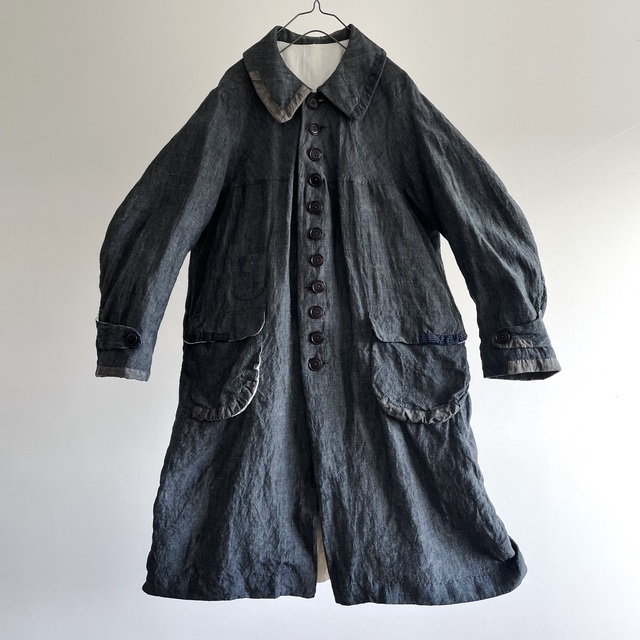
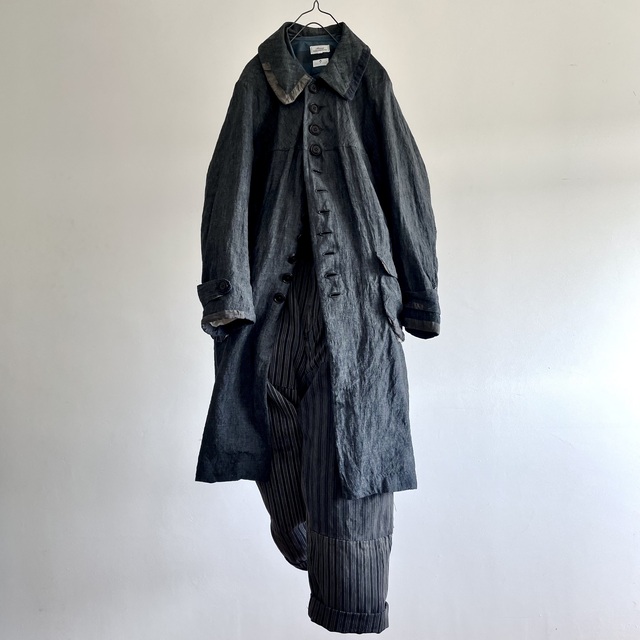
経緯共に緩めの素朴な質感の糸で織られた生地。リネンという名前の持つ上質や高級なイメージといった一面とは対極にある実用着としてのフランスの農村部で一番身近な素材としての野性味のあるはだかのリネン。
This fabric is woven with loose, rustic-textured yarns in both the warp and weft. The name “linen” has an image of high quality and luxury, but this is the opposite of that of the wild, bare linen that is the most familiar material in rural France as a practical garment.
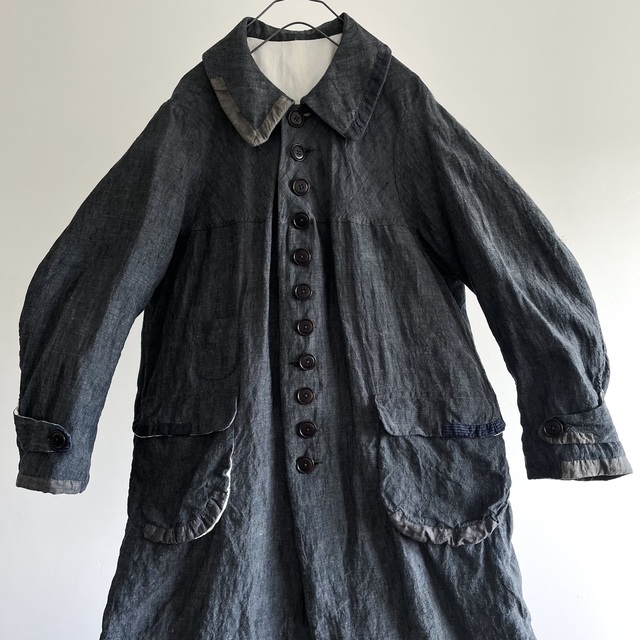
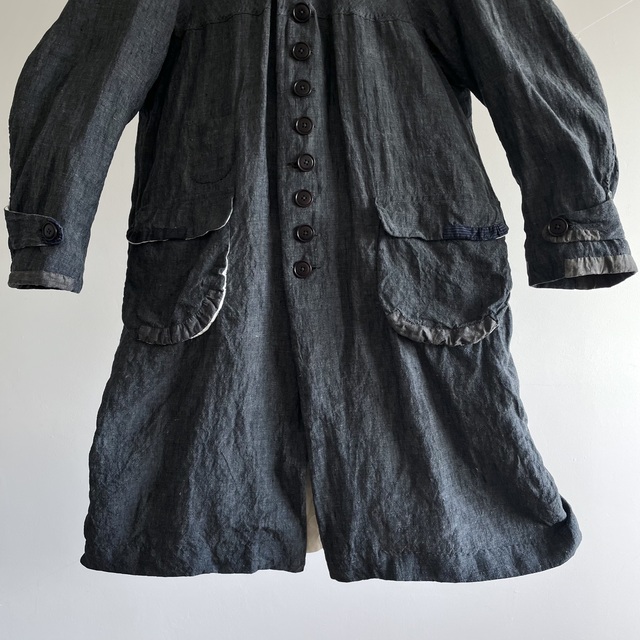
経糸に使われたインディゴ染の糸の色落ちを抑止し、堅牢度をたかるために鉄媒染を行った生地。鉄媒染の影響でグレーがかった深い色と手染めの素朴な風合いが生地の存在感を際立たせています。
This fabric is iron-mordanted to prevent the indigo-dyed yarn used for the warp from fading and to increase its colorfastness. The deep grayish color and rustic hand-dyed texture of the fabric stand out due to the iron mordanting process.
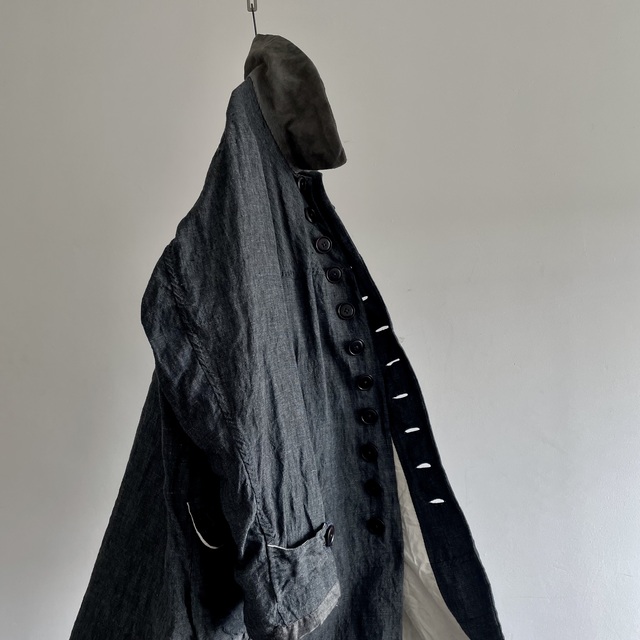
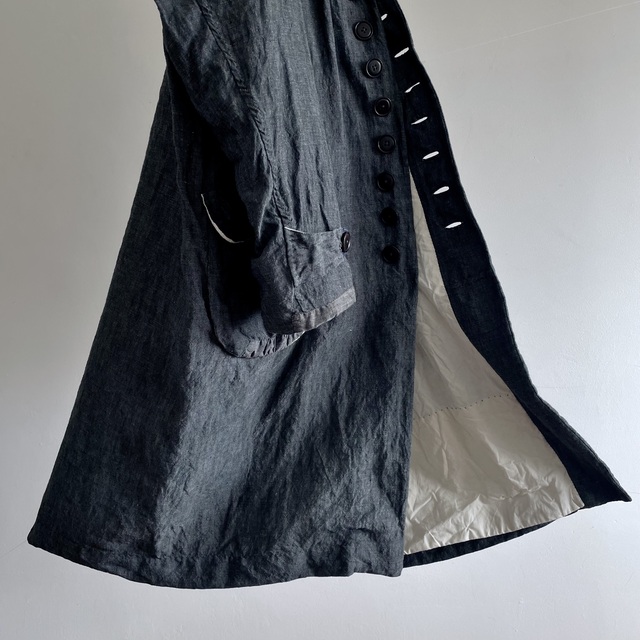
今なお世界のリネン原料のフラックス(亜麻)生産の70%を生み出し続けるフランスは、文字通りのリネン大国です。栽培には温帯から熱帯の気候を必要とするため、綿の栽培が難しいフランスの気候に適した亜麻は、衣類のみならずシーツなどの寝具や寝間着などのホームリネンから、テーブルクロスやナプキンなどのテーブルリネンにも使われフランス人にとっては綿以上に生活に密着した最も身近な繊維です。
France is literally a linen powerhouse, as it still produces 70% of the world’s linen flux (flax). Flax is used not only for clothing, but also for home linens such as sheets and bedclothes, table linens such as tablecloths and napkins, and is the most familiar fiber to French people, more closely related to their daily lives than cotton. It is the most familiar fiber to the French people, more closely related to their daily lives than cotton.
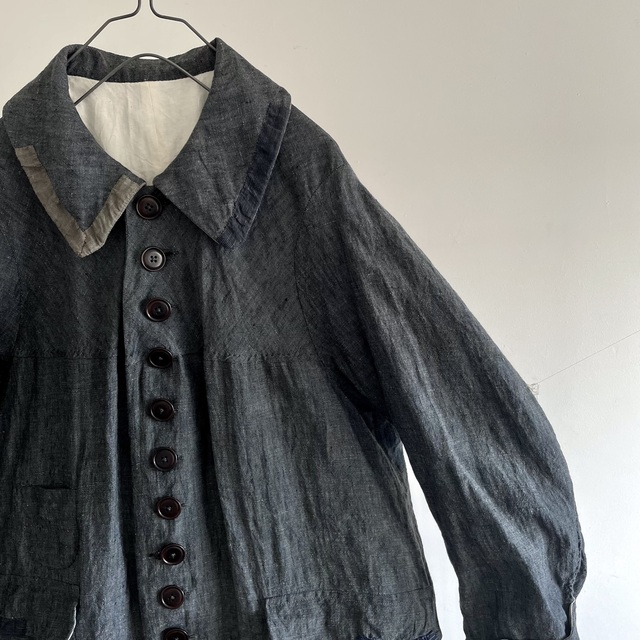
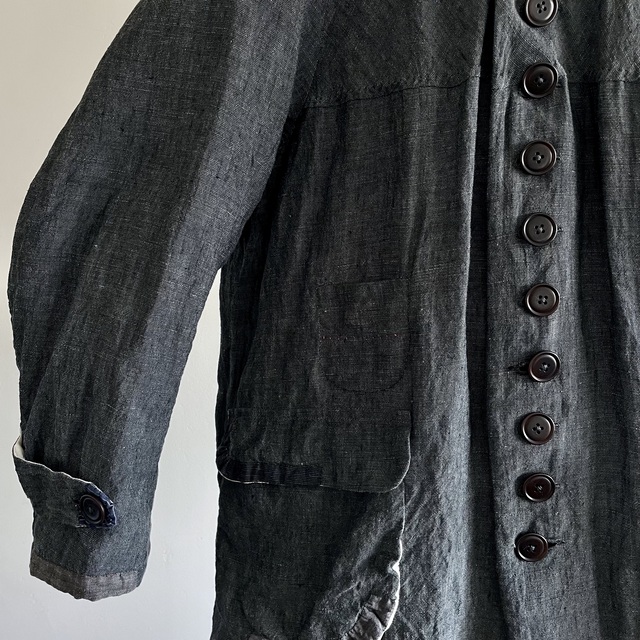
このコートの原型となったコートは、19世紀末から20世紀初頭の頃のもの。直線の四角形のパーツで構成されていて、その直線の組み合わせに施したギャザーでボリュームと運動量を確保した農家手作りのスモックなどのワークウェアから、テーラーの流れを取り入れた工業製品でありプロフェッショナルメイクのワークウェアへ移り変わる過渡期を暗示するようなユニークな組み合わせで仕立てられています。
The prototype of this coat dates from the end of the 19th century to the beginning of the 20th century. It is composed of straight rectangular parts, and the gathers applied to the combination of straight lines ensure volume and mobility, suggesting a transitional period from farmer’s handmade smocks and other workwear to industrial and professionally made workwear that incorporated the tailor’s trend. The unique combination is tailored.
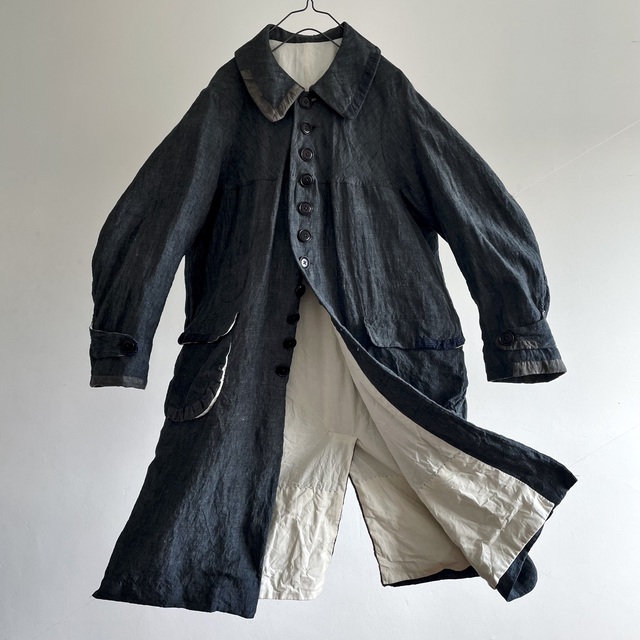
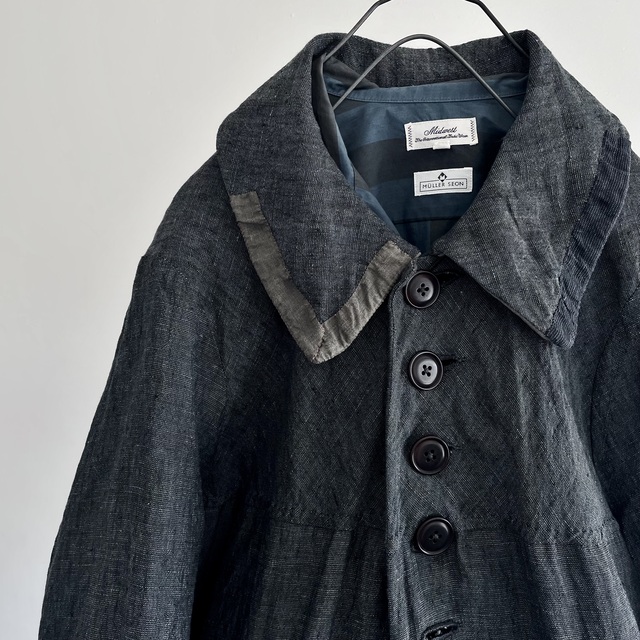
フランスの農村部などで作られた古い仕事着には、一般的にイメージされるフレンチワークウェアとは別の魅力が溢れています。
Old work clothes made in rural areas of France and other regions are full of a different kind of charm from the French work wear generally associated with them.
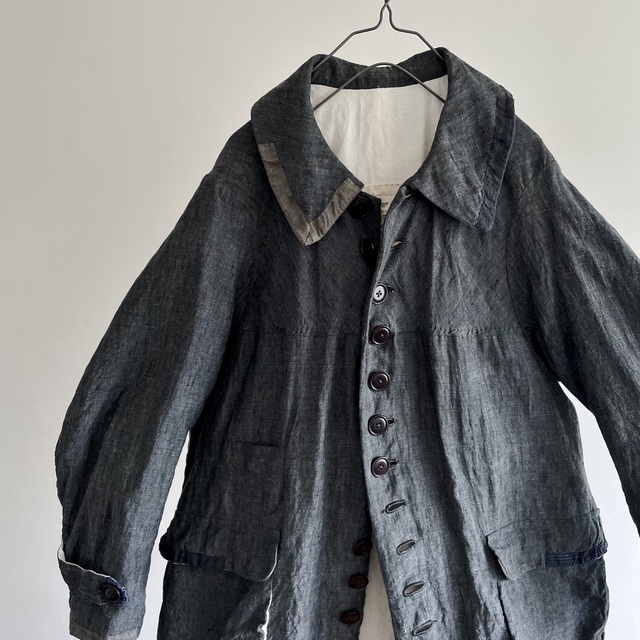
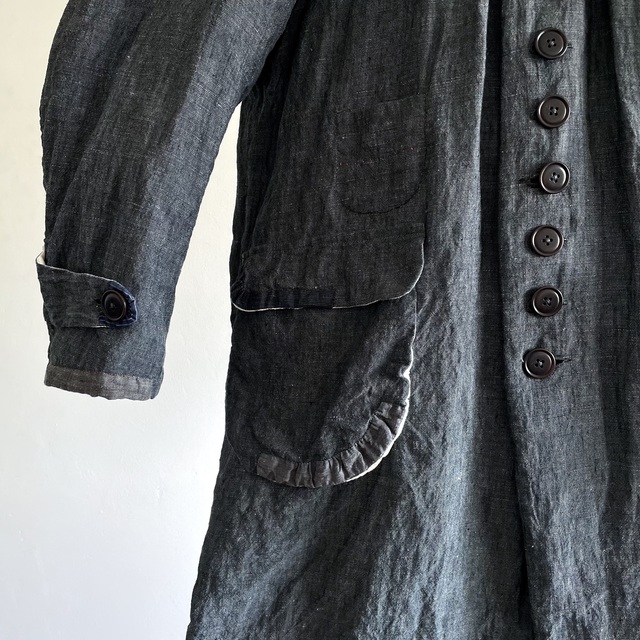
19世紀末頃から、都市部とその近郊地域での産業や商業の発展とともに発達し、産業革命や近代化の結晶としてのワークウェアは、服飾知識と技術を持った専門家によるデザインとパターン製作や、縫製や工程の管理を基本とした、ワークウェア自体が立派な商品となる工業生産品でした。
特にフランスのものは、テーラーワークを基本にしたパターンと縫製が作り出す立体的で曲線的なデザインと、雰囲気溢れる表情が今でも独特の魅力を持っています。
Workwear, which developed with the development of industry and commerce in urban and suburban areas from around the end of the 19th century, was the fruit of the Industrial Revolution and modernization, and was an industrial product that became a respectable commodity in itself, based on design and pattern making by experts with clothing knowledge and skills, and sewing and process control. The workwear itself was an industrial product that became a respectable commodity.In particular, French items still have a unique charm with their three-dimensional, curvilinear designs and atmospheric expressions created by patterns and sewing based on tailor work.
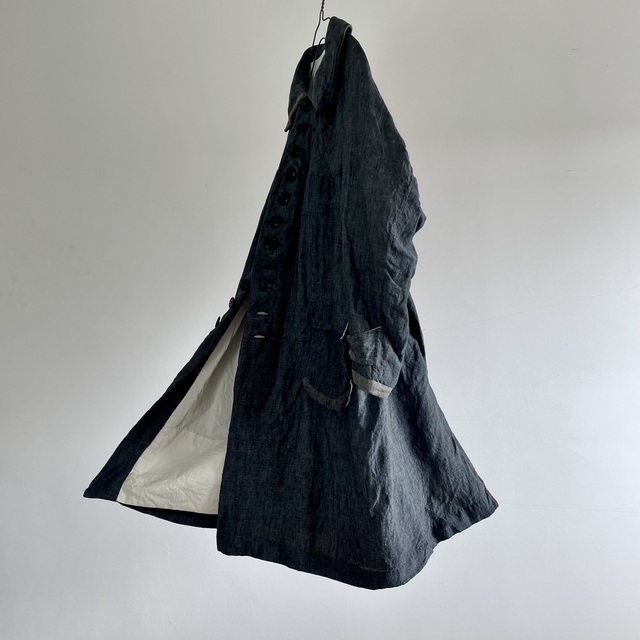
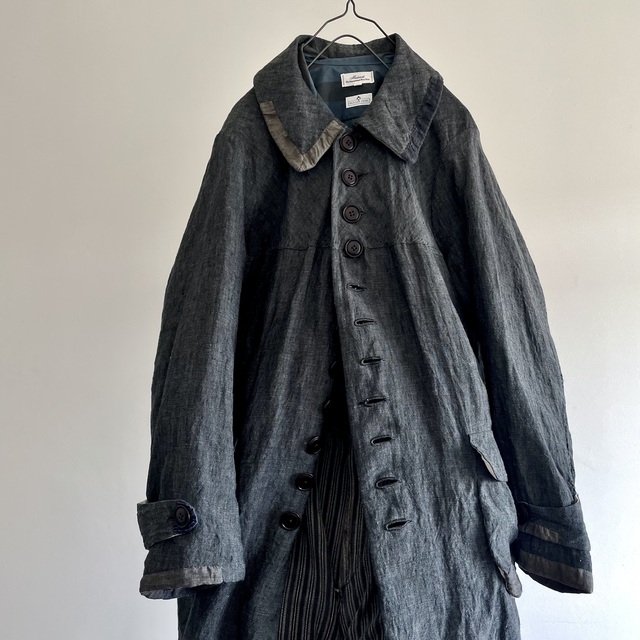
一方、周辺の農村部などでは、生活や仕事着が近代化されるのは1900年代の中期以降でした。今も食糧自給率が120%を超え、欧州連合(EU)一の農業生産国のフランスには、民族衣装から発展し、牧畜に従事する人々が作り上げたBiaudeや、農家の室内着や寝間着になったスモックなど豊かな感性に彩られたフランス独自の様々な衣料や仕事着が自らの手や町の仕立て屋で手作りされていました。
In the surrounding rural areas, on the other hand, it was not until the mid-1900s that people began to modernize their lifestyles and work clothes. France, which is the largest agricultural producer in the European Union (EU) with a food self-sufficiency rate of more than 120%, had developed from national dress, and various types of clothing and work clothes unique to France, such as biaude made by people engaged in cattle raising and smocks that became indoor wear and nightwear for farmers, were handmade by the people themselves or by tailors in the towns. The clothes were handmade by the people themselves or by tailors in the towns.
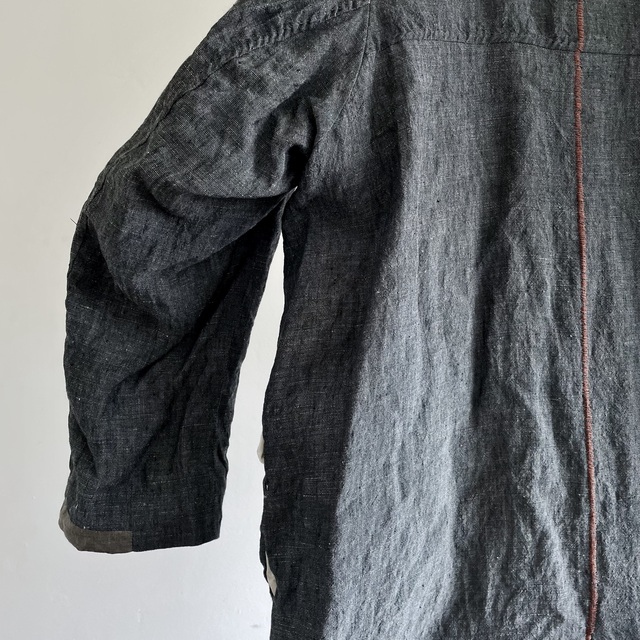
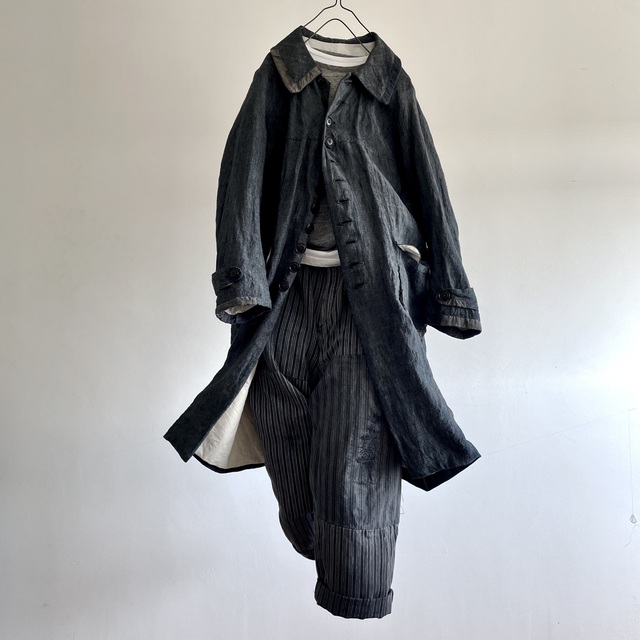
肩とヨーク部分のパーツが特殊な仕様の、とても珍しい造りで作られたコート。背中の接ぎを経地に合わせたヨークのパーツが、体に沿って前に回り込んでくるにつれて、しだいに生地方向が変化し、肩から胸にかけてがバイアス方向の生地使いとなり、肩の傾斜に馴染むとともに、腕の動きにも沿う伸縮性を持った、とても理にかなった作りです。
This coat has a very unusual construction, with the shoulder and yoke parts made of a single piece of fabric without any joints. The yoke part, which is joined at the back to the fabric, gradually changes direction as it goes around the front along the body, and the fabric is used on the bias from the shoulders to the chest, making it a very logical construction that conforms to the slope of the shoulders and also has elasticity that follows the movement of the arms.
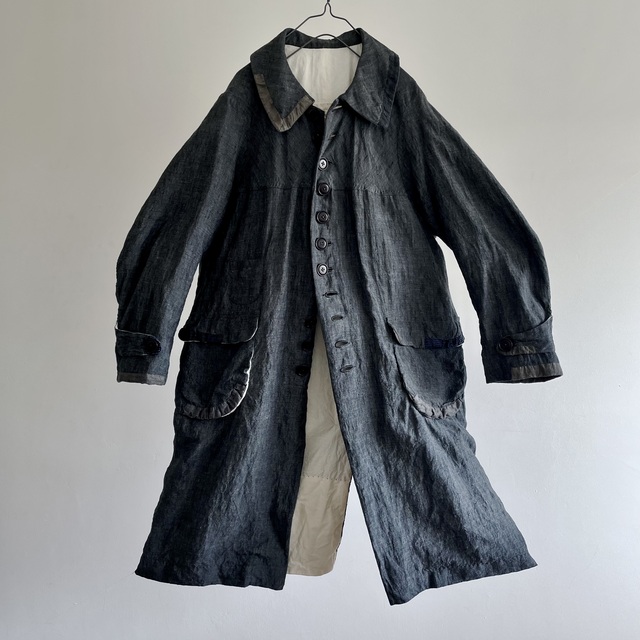
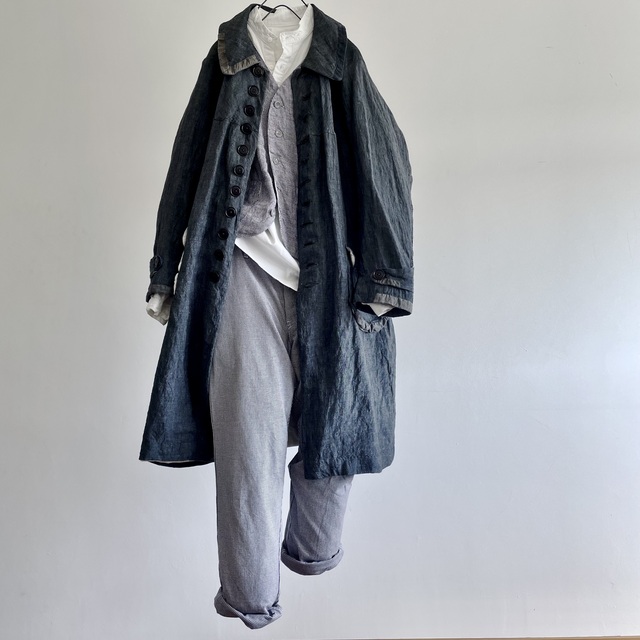
ナチュラルな肩のフォルムを作り出し、広い身幅と肩をバランスよく繋ぐパターンはフランスならではの発想だと思います。
The pattern that creates a natural shoulder form and connects the wide body width and shoulders in a well-balanced way is a uniquely French idea.
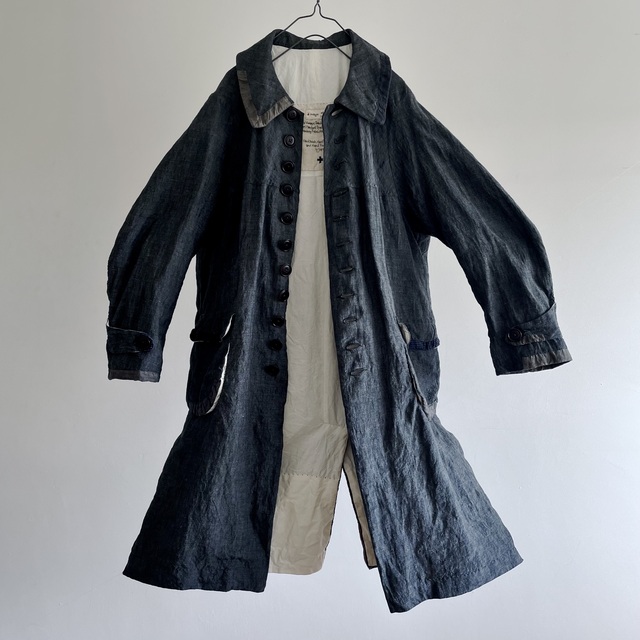
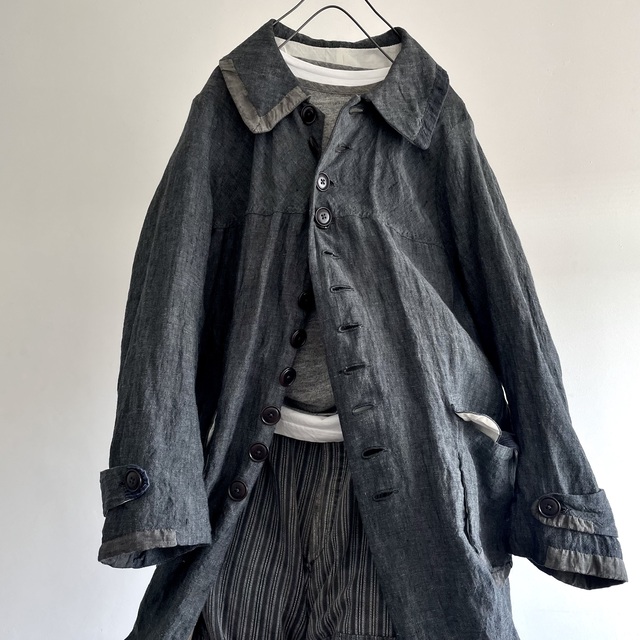
胸から下の身頃も、前身頃から背中の中心までを1枚で作り背中で繋いだたとてもユニークな設計。脇に接ぎがなくたっぷりとした身幅から裾に向かって緩やかに広がるシルエットは、比較的コンパクトな肩とのバランスの対比がユニークな味わいを深めてくれます。
The body from the chest down is also uniquely designed, made in one piece from the front to the center of the back and connected at the back. The silhouette gently widens from the generous body width to the hem without any side joins, and the contrast between the relatively compact shoulders and the balance of the body deepens the unique flavor of the garment.
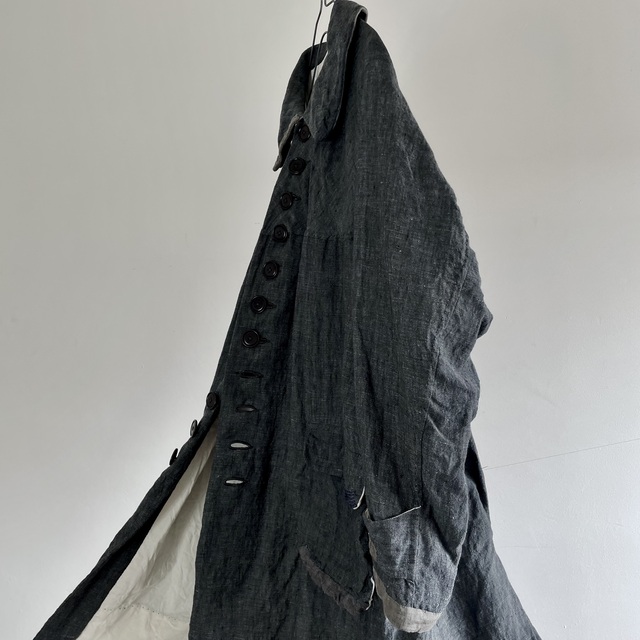
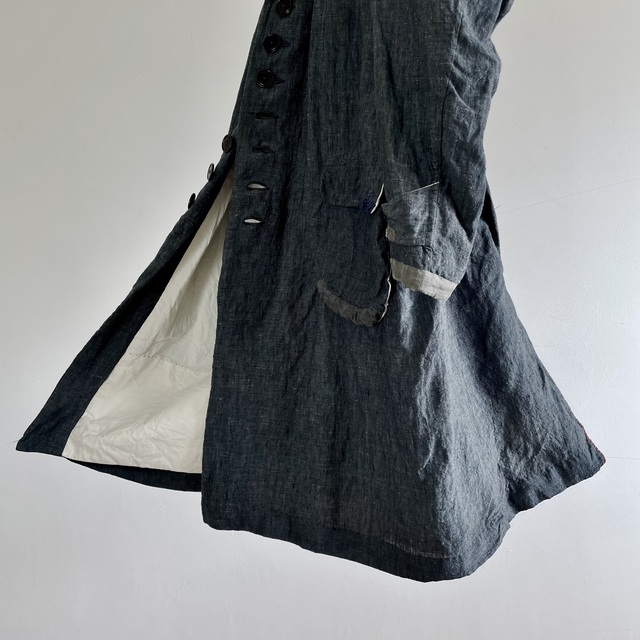
ユニークで立体的な発想の肩ヨークに、生地の横幅をそのまま利用して無駄なく生地を使って、繋ぎ合わせただけのまっすぐな身頃を合わせた面白い仕立て。ここに腕に沿った曲線を描く2枚袖の腕と、特徴的なフラットな衿といった組み合わせ。
The unique and three-dimensional conception of the shoulder yoke is combined with an interesting tailoring that uses the width of the fabric as it is without wasting any fabric, and with a straight body that is just joined together. The two-piece sleeves that curve along the arms and the characteristic flat collar are combined here.
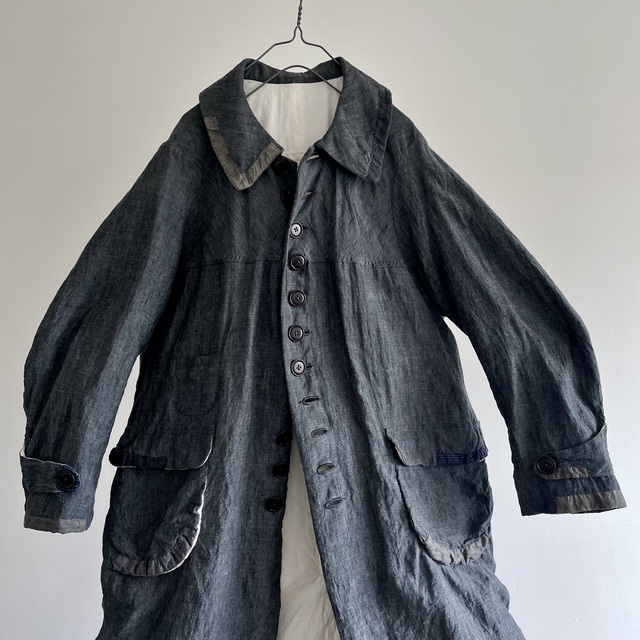
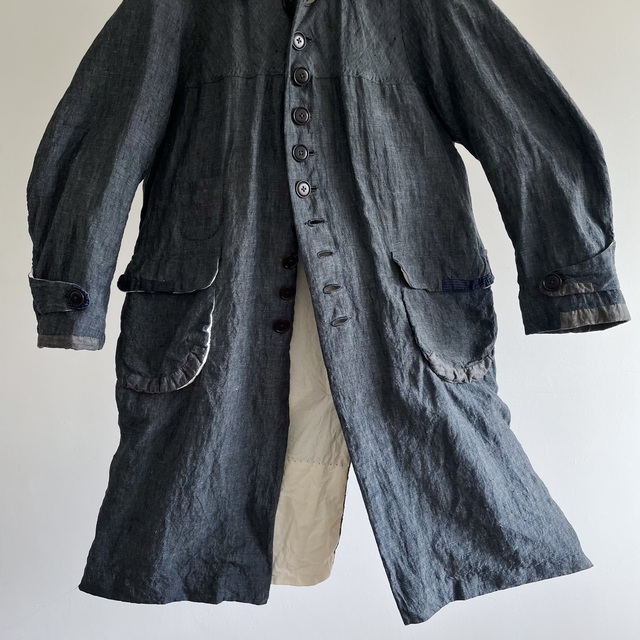
古いフランスの仕事着によく見られる、衿を1枚で作らずに強くカーブした2枚のパーツを継いだ、身頃に沿う形のフラットながらもボリュームのある衿。この衿も立体的なパターン発想が作り出したフランスならではのもの。
The collar, often seen in French workwear of this period, is not made of a single piece but is made of two strongly curved parts that are joined together to form a flat but voluminous collar that follows the body. This collar is also a uniquely French creation of a three-dimensional pattern conception.
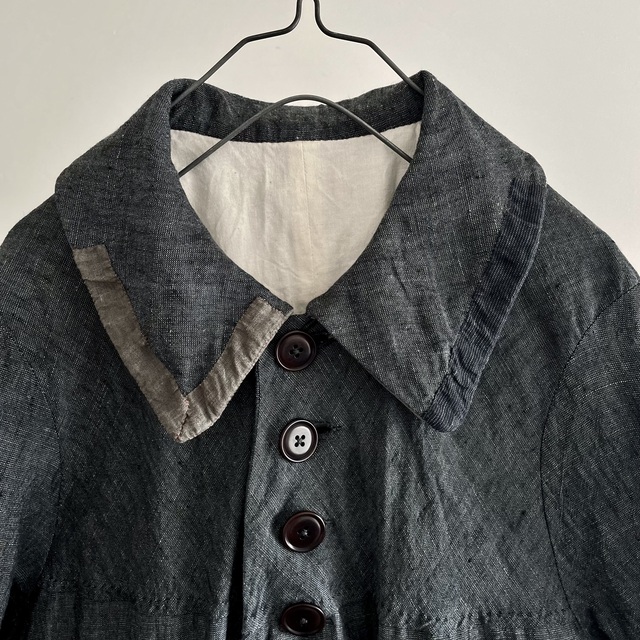
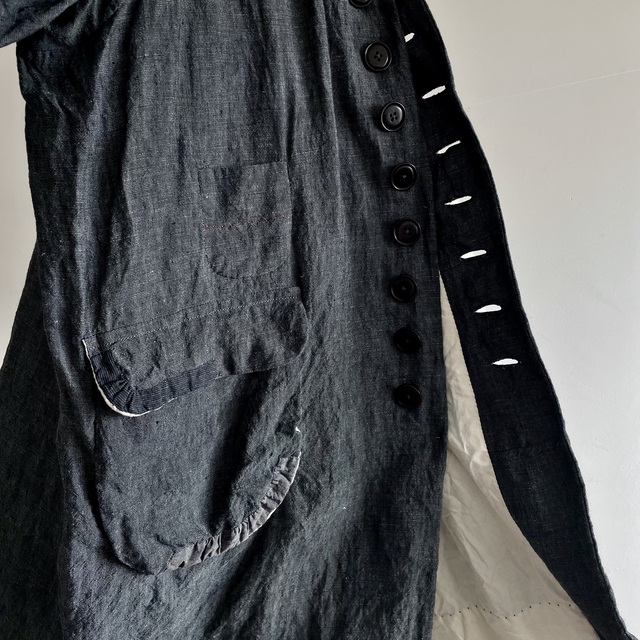
衿裏に選んだのも、フランスのアンティークのリネン生地です。
The linen fabric chosen for the back of the collar is also an antique French linen fabric.
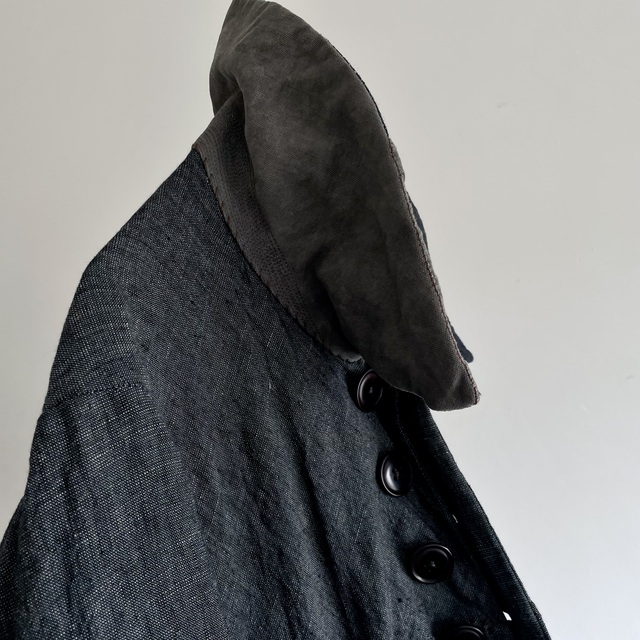
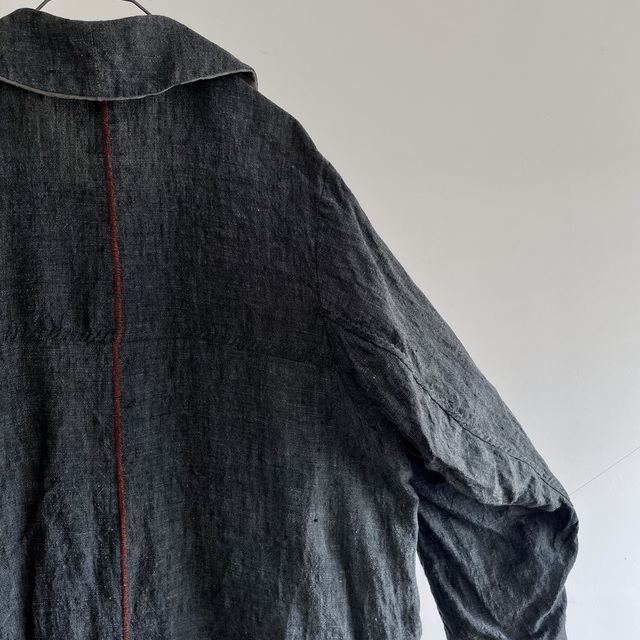
時間を経たvintage故の生地の変化。煤汚れや日焼けによる色斑と枯れた感触は古い生地ならではの味わい。
The change of fabrics due to the passage of time. The color spots and withered texture caused by soot stains and sunburn are the unique taste of old fabrics.
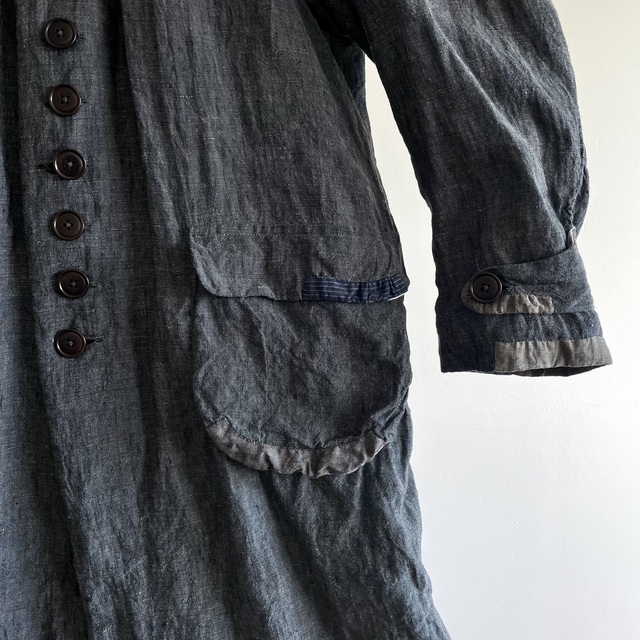
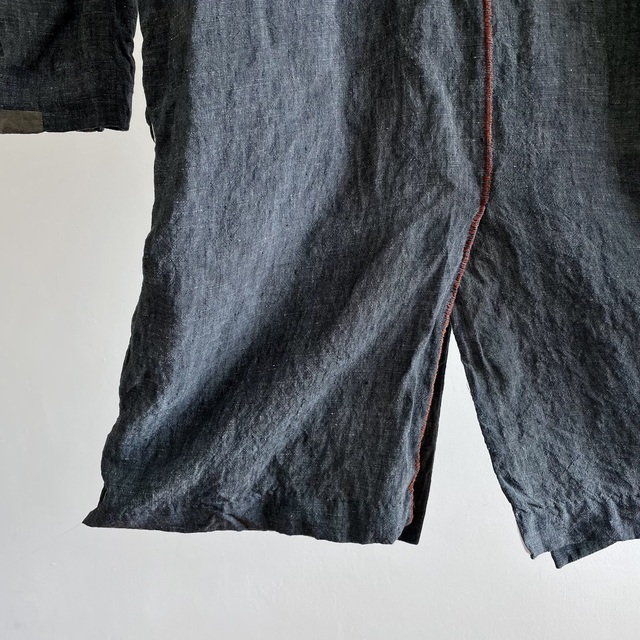
ヘムを軽くするために、止めつけずに浮かせてつけたライニングの裾。適度なボリュームを持たせるために深い見返しをつけ、ハンドステッチでアクセントを添えています。
To lighten the hem, the lining hem is floated instead of sewn. A deep turnover is added to give the right amount of volume, and hand-stitched accents are added.
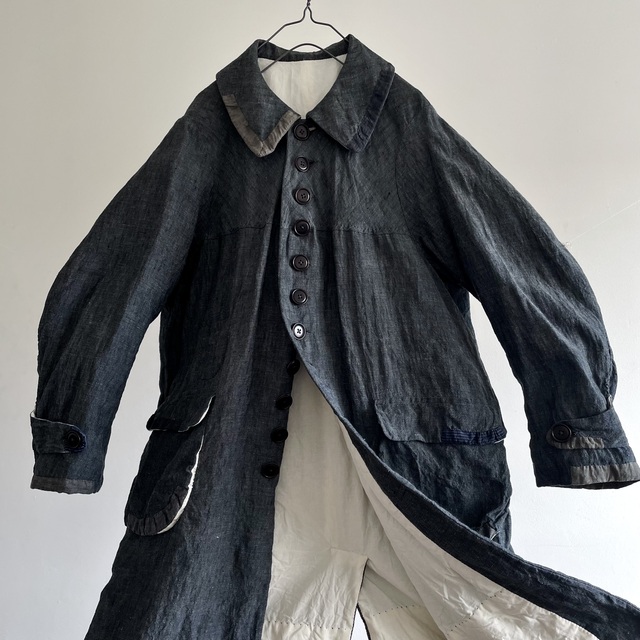
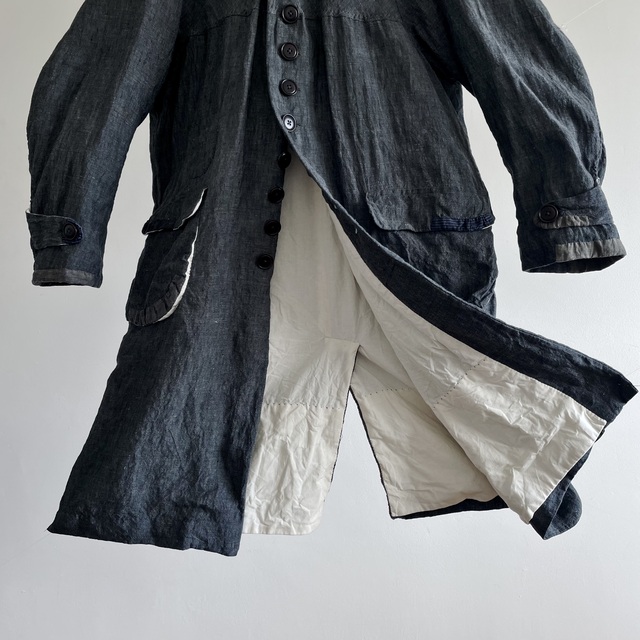
ハンドステッチでのライニング。手の温もりではなくストイックさを伝える不揃いなステッチ、縫い皺の表情や生地のコントラストが乾いた奥行きを作り出します。
Lining with hand stitching. Uneven stitching that conveys stoicism instead of hand warmth, the expression of stitch wrinkles and fabric contrast create a dry depth.
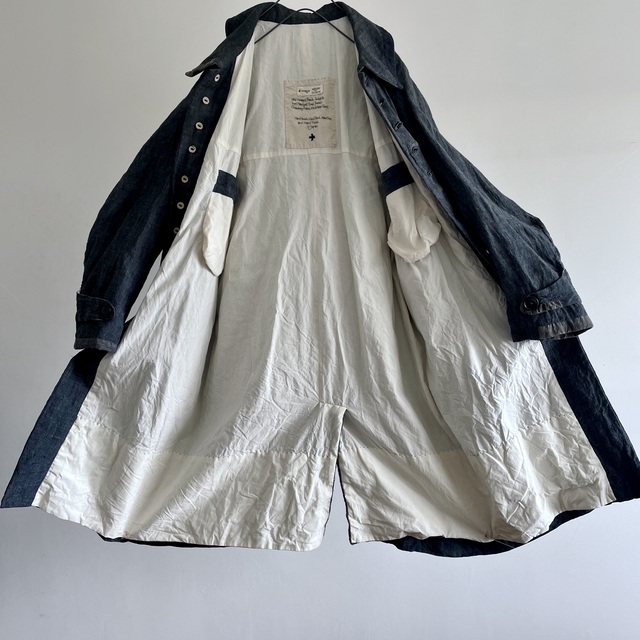
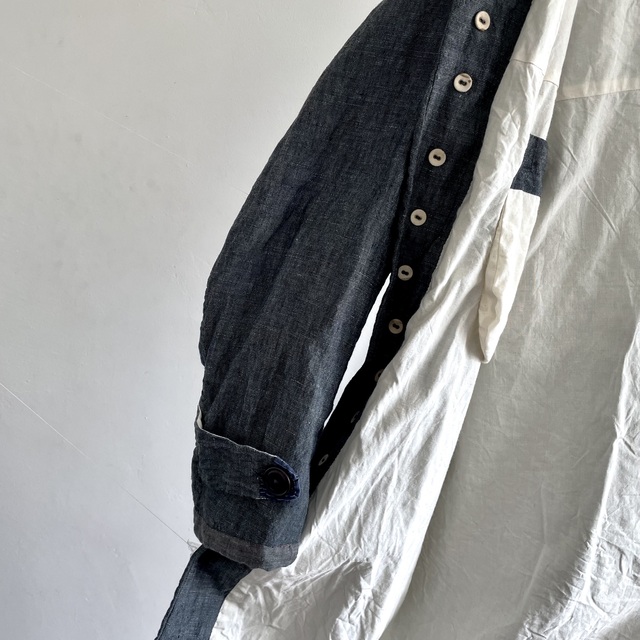
背中の縫割りの縫い目の一部に施した手縫のステッチ。控えめに主張する乾いた手仕事。
Hand-stitched stitches on back seam allowances. Dry handwork that discreetly asserts itself.
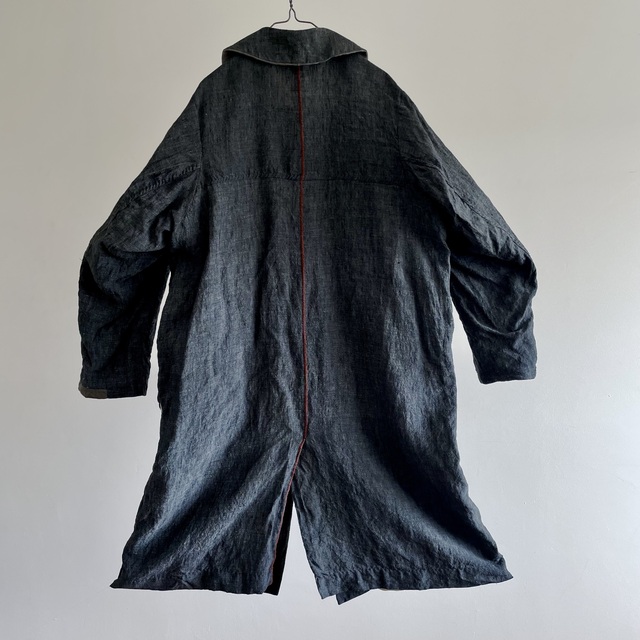
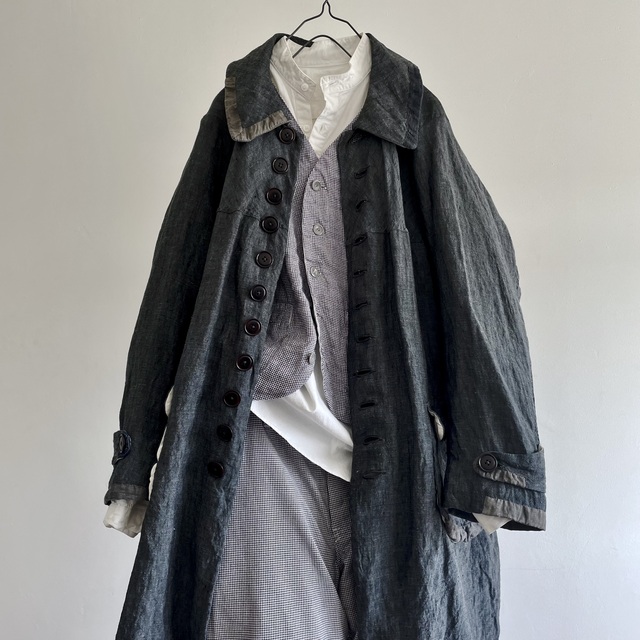
ヨーク部分の生地の方向が、肩から胸にかけてバイアス方向に変化するユニークな仕様。
The yoke portion of the fabric changes direction on the bias from the shoulders to the chest, a unique specification.
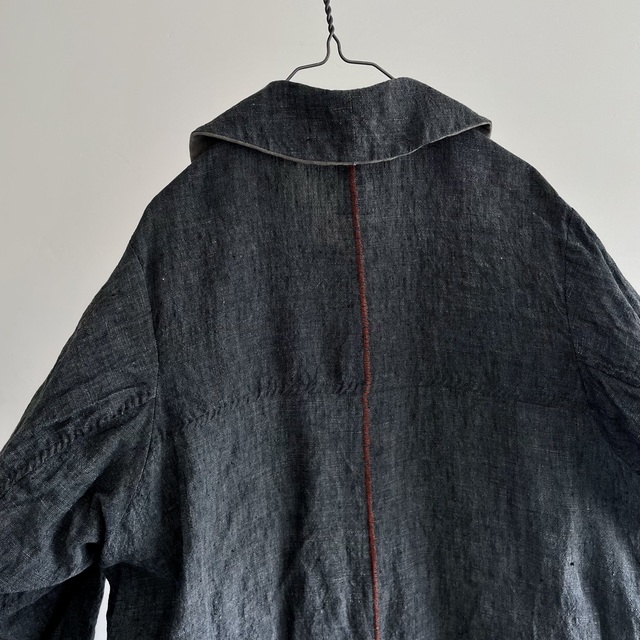
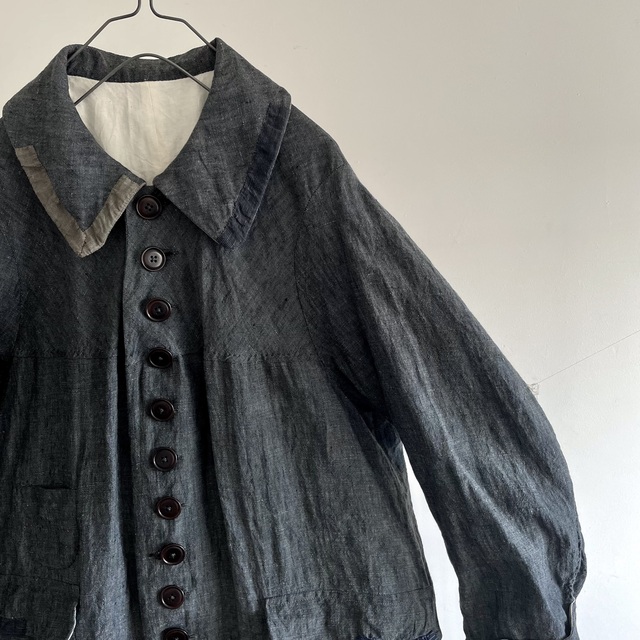
狭めの間隔でずらりと並べたボタンの迫力のある表情。
The powerful look of buttons arranged in a row at narrow intervals.
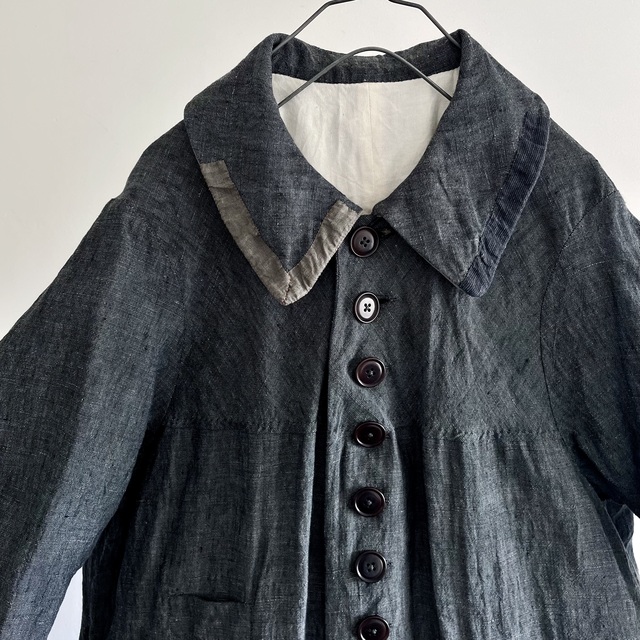
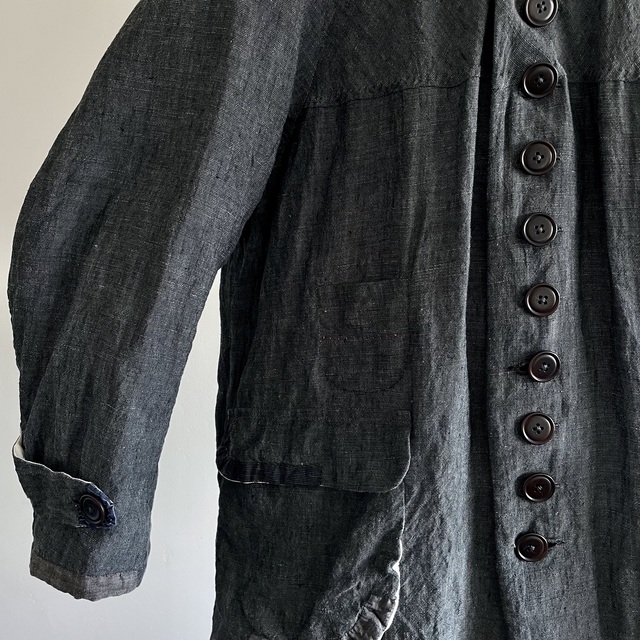
ボタンはフランスのヴィンテージのcorozo(主にエクアドルのタグワ椰子)。実の中の種子の中の胚乳部分を加工して作られた趣のあるボタン。
19世紀から1950年代にかけてのプラスティック開発以前に、滑らかな手触りと硬さ丈夫さ染色性の良さを利用して、盛んに作られていたボタンです。
The buttons are vintage French corozo (mainly tagua palms from Ecuador). These quaint buttons are made by processing the endosperm part of the seeds inside the fruit.
Before the development of plastics from the 19th century to the 1950s, these buttons were actively made to take advantage of their smooth feel, hardness, durability, and dyeability.
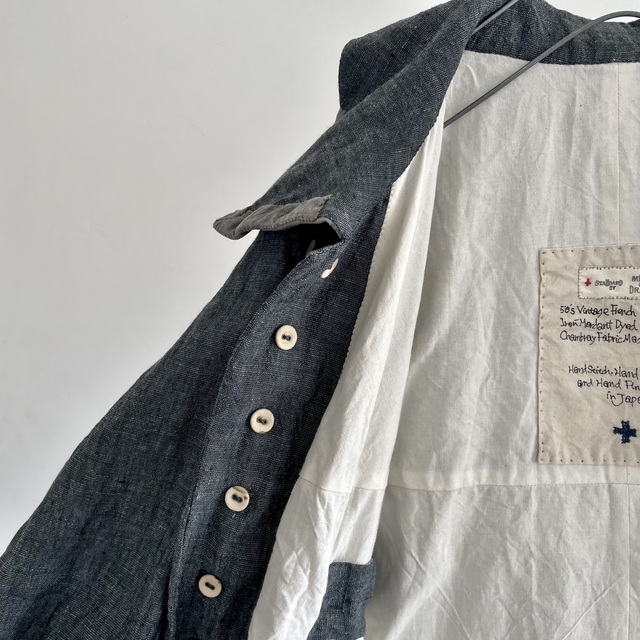
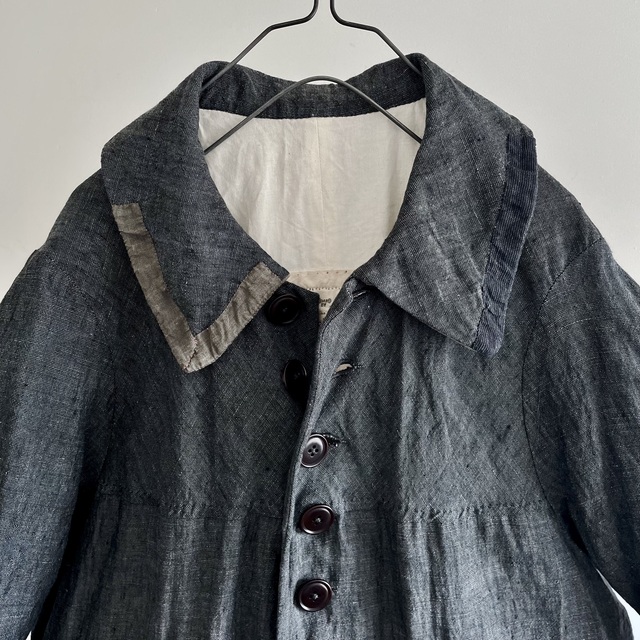
vegetable ivoryの呼び名通りの乳白色の実を削って加工される何とも言えない丸みと、乳白色のベースを染める事で生まれる優しい色合いの魅力。見た目に反してしっかりした質感と重みを兼ね備えた、味わい深さを持ったボタンです。
As the name “vegetable ivory” implies, this button has an indescribable roundness created by shaving milky white berries, and the charm of the gentle coloring produced by dyeing the milky white base. Contrary to its appearance, this button has a solid texture and weight, and has a deep sense of taste.
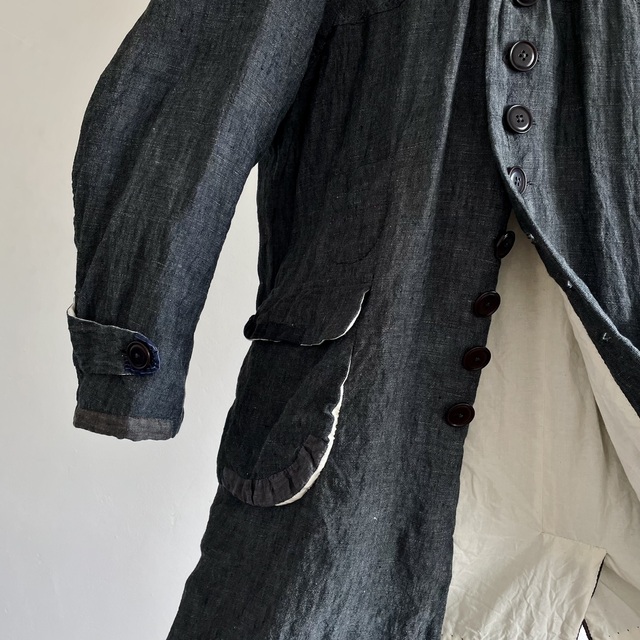
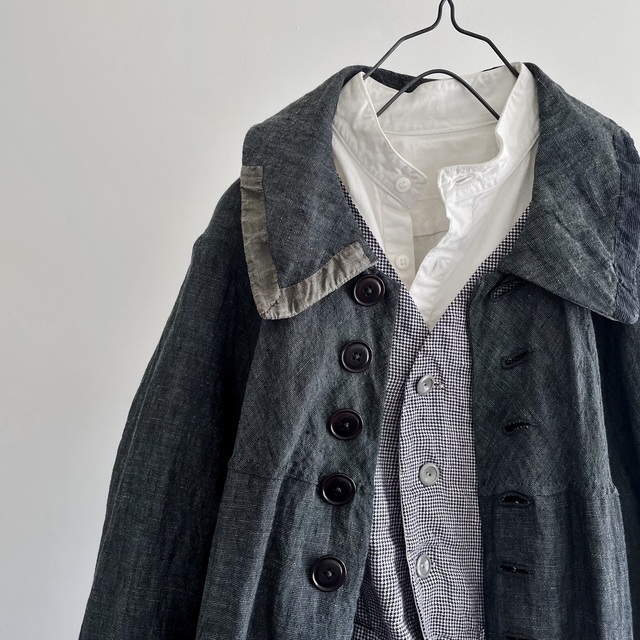
ボタンホールも全て手縫いです
Buttonholes are also all hand-stitched.
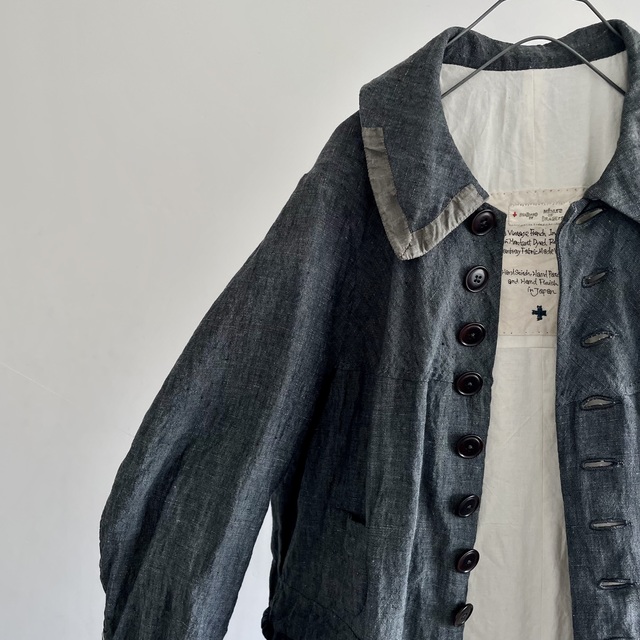
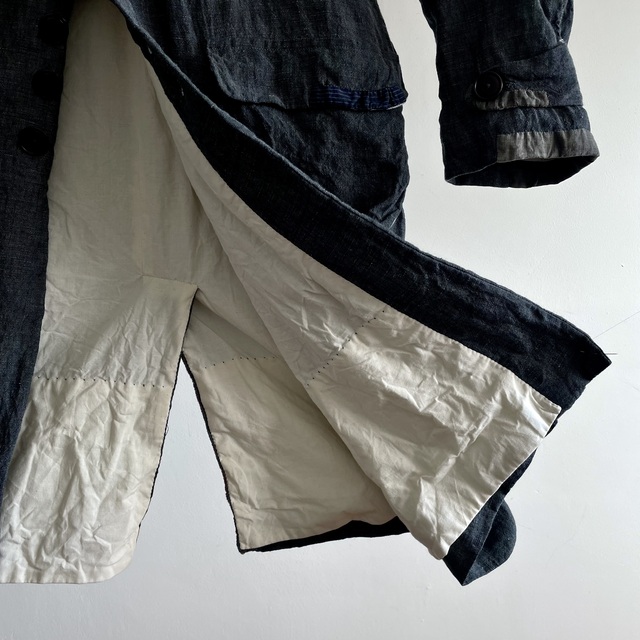
Vintageの生地と、今はもう作られなくなった仕事着のフォルム。そこに乾いた手の仕事と現代性を融合させて作り上げた、コートです。着る人の個性と存在感を際立たせる1着です。
Vintage fabric and the form of work clothes that are no longer made. This coat was created by fusing the dry work of hands with modernity. It is a garment that accentuates the individuality and presence of the wearer.
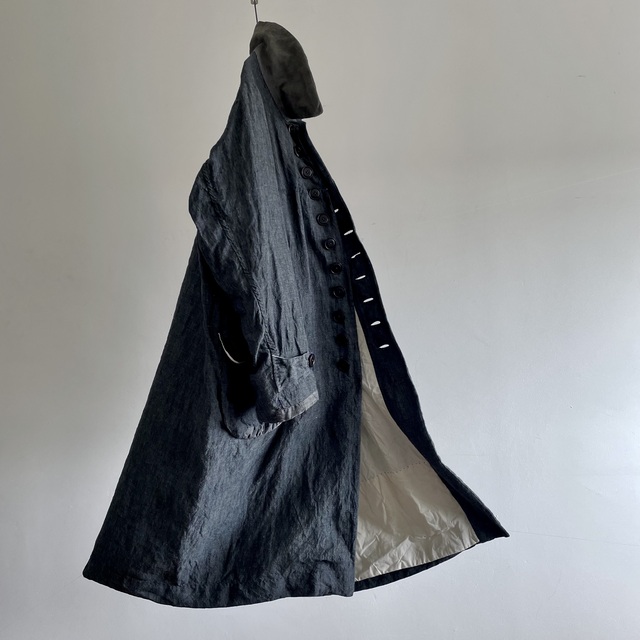
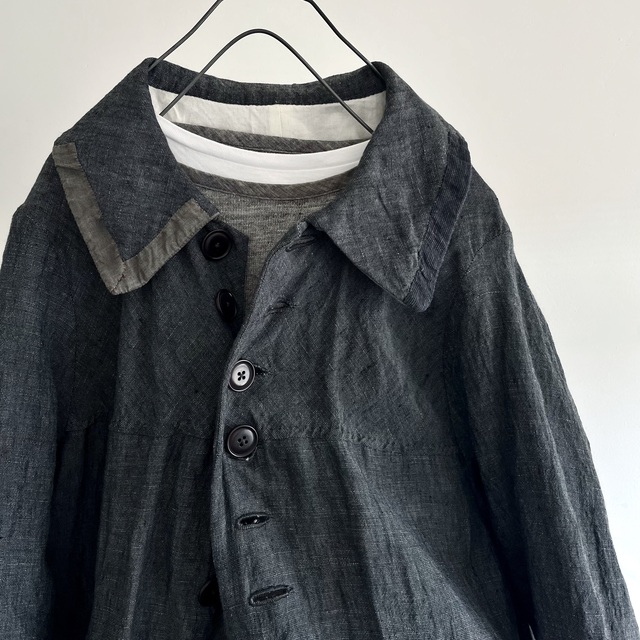
サイズ 2
肩幅 = 45cm
バスト= 63cm (脇下)
袖丈 = 62cm
着丈 = 103cm
フランス/日本製
Front Fabric = Indigo&Iron-Mordant Dyed Chambray/ Linen 100%
Back Fabric = Indian Rustic Cotton Broad Cloth / Cotton100%
Buttons =1950-1960 Vintage French Corozo Button
& Antique Fabric Covered Button
STOREへのリンク
[STANDARD By Manure Of Drawers] SOLD

